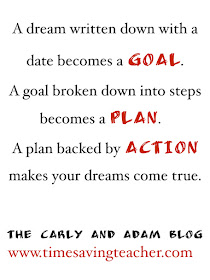We all have dreams. So why is it that some people's dreams become a reality while other dreams are lost or discarded along the way?
I recently finished the book The Principle of the Path: How to get from where you are to where you want to be. In the book Andy Stanley continually reinforces the idea that
"our direction, not intention, determines destination."
For example, if my goal is to lose weight, but I'm continually going to the teacher's lounge to snack on leftover cupcakes then my actions do not match my intention.
In order to get from where you are to where you want to be there are three key steps:
STEP 1: Set a Goal and Write It Down
What is a goal that you have? Perhaps you want to be more organized or maybe you want to be able to leave work at a decent hour. Whatever your goal is be sure that it is realistic, write it down, and set a date for completion.
STEP 2: Break Your Goal Down into Daily Action Steps
After setting your goal break it down into a series of 3-5 daily action steps that will help you reach your goal. These may need to be modified weekly or monthly as you find the most effective strategies to get you where you want to be. One additional tip is to put the hardest or the least desirable task on your list first so that you are more likely to get it done.
For example, my daily action steps to reach my goal of growing my Teachers Pay Teachers store are to work on products for my store and brainstorm ideas, write one new blog post a week, read at least one chapter a day for professional development or listen to a podcast and post to my Facebook page at least three times a day.
Once you have set your goals and created your action steps there is one final thing...
STEP 3: Actually, Do Them
In order for you to reach your goal you have to actually follow through with the plan that you created. If we were honest with ourselves this oftentimes is the biggest obstacle keeping us from reaching our goals.
The problem is that in order to accomplish the goal, our priorities have to change. It is just like Andy Stanley said, "Our direction, not intention, determines destination." If we are serious about reaching our goal our actions much match our intention.
What direction are you moving in?
Is it a direction that is taking you closer to your goal or farther away from it?
Remember that writing down your goals is a good way to keep yourself accountable. Feel free to write your goal in the comments section below.
We would love to hear your thoughts. Please leave your feedback in the comments. We can't wait to connect with you!
-Carly











